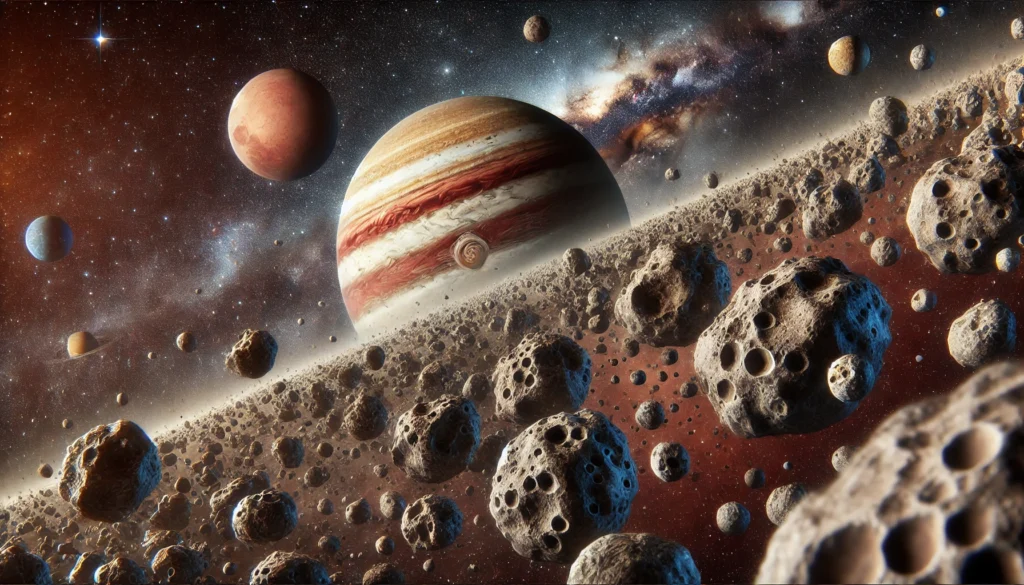Greetings, space adventurers! Captain Nova here, ready to guide you through Day 14 of our “100 Days of Space Exploration.” Today, we’re navigating to a fascinating region of the Solar System—a place teeming with rocky remnants of the past. Buckle in as we venture into the Asteroid Belt, that mysterious expanse between Mars and Jupiter. Let’s uncover the secrets of these celestial rocks and explore their role in the grand story of our Solar System.

What Is the Asteroid Belt?
The Asteroid Belt is a toroidal region of space situated between the orbits of Mars and Jupiter. This vast area is home to millions of asteroids, ranging from tiny pebbles to massive bodies hundreds of kilometers wide. Despite the high number of objects, the Belt is far from densely packed. In fact, spacecraft can easily navigate through it without incident, as the asteroids are scattered over an immense distance.
- Location: Approximately 329 to 478 million kilometers (205 to 297 million miles) from the Sun.
- Thickness: Roughly 1 AU (astronomical unit), or about 150 million kilometers.
- Key Players: Ceres, Vesta, Pallas, and Hygiea—the four largest asteroids, which account for nearly half the total mass of the Belt.
Formation: A Failed Planet?
The story of the Asteroid Belt begins over 4.5 billion years ago, during the early days of the Solar System. As the Sun formed, a swirling disk of gas and dust surrounded it, eventually coalescing into planets. However, in the region between Mars and Jupiter, gravitational disturbances from the massive gas giant prevented the material from forming a single planet. Instead, these remnants remained as smaller, rocky bodies—the asteroids we observe today.
Scientists believe studying the Belt provides critical insights into the processes that shaped our Solar System. These asteroids are like time capsules, preserving the composition and conditions of the primordial solar nebula.
The Major Players
Let’s take a closer look at some of the most notable residents of the Asteroid Belt:
- Ceres: The largest object in the Belt and the only dwarf planet within it, Ceres has a diameter of about 940 kilometers (584 miles). It even has water-ice beneath its surface and a thin atmosphere, making it a candidate for potential signs of life.
- Vesta: With its impressive mountains and impact craters, Vesta is one of the brightest asteroids and has been studied in detail by NASA’s Dawn mission. It’s known for its basaltic surface, indicating volcanic activity in its past.
- Pallas: An intriguing asteroid with a highly inclined orbit, Pallas is the third-largest object in the Belt. Its unique trajectory suggests it had a turbulent history.
- Hygiea: Slightly smaller than Vesta, Hygiea is notable for its nearly spherical shape, which qualifies it as a dwarf planet candidate.
Composition and Types of Asteroids
Asteroids in the Belt vary widely in size, shape, and composition. Based on their reflective properties and spectral data, scientists classify them into three main types:
- C-type (Carbonaceous): These are the most common and are composed mainly of clay and silicate rocks. They’re dark in appearance and contain organic compounds, hinting at the ingredients for life.
- S-type (Silicaceous): Made of silicate minerals and nickel-iron, S-type asteroids are relatively brighter and are thought to have undergone some heating and differentiation.
- M-type (Metallic): These are composed mostly of nickel and iron, likely remnants of the cores of larger bodies that were shattered in collisions.
Scientific Significance
Why do we care about the Asteroid Belt? For one, it offers a unique opportunity to study the building blocks of the planets. By examining asteroids, scientists can:
- Understand the conditions of the early Solar System.
- Learn about the processes that led to planet formation.
- Investigate the potential for life’s building blocks beyond Earth.
Moreover, some asteroids contain precious metals and water, which could be invaluable resources for future space exploration and even colonization efforts.
Exploration of the Asteroid Belt
Humanity’s curiosity has already led us to this intriguing region. NASA’s Dawn mission, launched in 2007, studied Vesta and Ceres, revealing stunning details about their surfaces and compositions. Other missions, like Japan’s Hayabusa and NASA’s OSIRIS-REx, have collected samples from asteroids near Earth, further expanding our understanding of these ancient objects.
The Role of Jupiter
The giant planet Jupiter plays a crucial role in shaping the Asteroid Belt. Its immense gravitational pull acts as a barrier, preventing the Belt’s material from coalescing into a planet. At the same time, Jupiter’s gravity occasionally sends asteroids hurtling toward the inner Solar System, where they become meteoroids, and some even reach Earth as meteorites.
Potential Hazards and Benefits
While the Asteroid Belt itself poses no direct threat to Earth, some asteroids occasionally stray from their orbits and become near-Earth objects (NEOs). Monitoring and tracking these NEOs is essential for planetary defense, as a collision with a large asteroid could have catastrophic consequences.
On the flip side, asteroids also present exciting opportunities. Mining asteroids for resources like water, metals, and even rare Earth elements could revolutionize space exploration and provide materials for constructing habitats and spacecraft in orbit.
A Gateway to the Outer Solar System
The Asteroid Belt marks the boundary between the terrestrial planets and the gas giants. It’s a region that connects two very different worlds, serving as a gateway to the outer Solar System. As we journey through it, we’re reminded of the dynamic forces that shaped our cosmic neighborhood and the potential it holds for future discoveries.
Closing Thoughts
As I gaze out from the Odyssey Explorer, the vast expanse of the Asteroid Belt stretches before us, a cosmic graveyard of ancient rocks. Each asteroid tells a story, a fragment of a grander narrative about our place in the universe. Tomorrow, we’ll delve even deeper into the outer reaches of the Solar System, exploring the icy and mysterious Kuiper Belt. Until then, keep your curiosity alive and your imaginations soaring.
Captain Nova
Odyssey Explorer
Leave a Reply